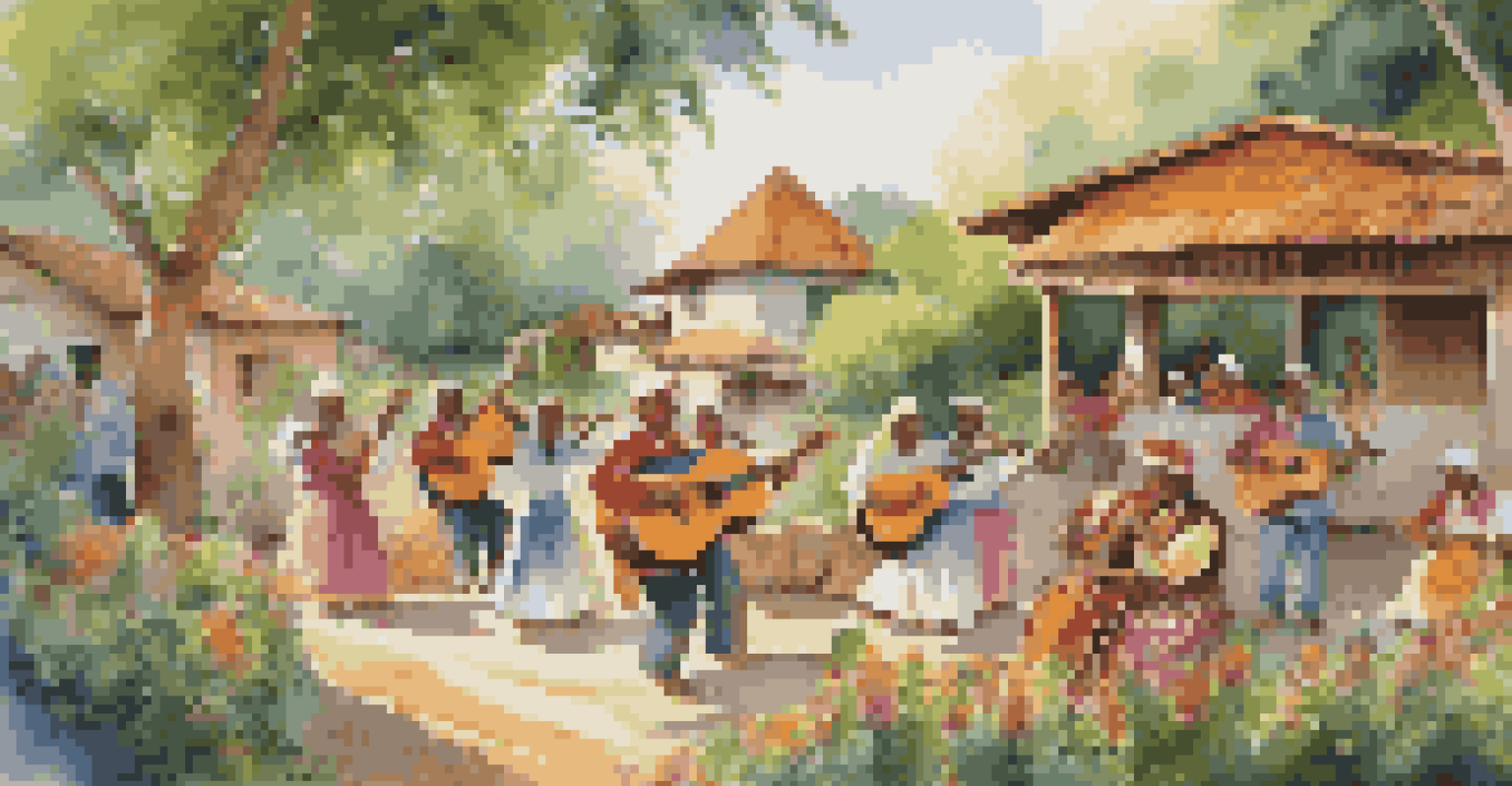Exploring the Use of Music in Documentary Filmmaking

Setting the Tone: How Music Shapes Documentaries
Music plays a pivotal role in setting the tone of a documentary. It can evoke emotions, create tension, or provide relief, guiding the audience's reactions throughout the film. For instance, a haunting melody can deepen the impact of a serious subject, while an upbeat track might bring a sense of hope or joy.
Music is the shorthand of emotion.
Think of documentaries that tackle heavy themes, such as social justice or environmental issues. The right music can amplify the urgency of the message, making it more compelling and resonant. Without music, the emotional weight of these subjects might not be as effectively conveyed.
Ultimately, music becomes a character in the documentary itself, influencing how viewers perceive the narrative. This dynamic relationship between music and storytelling is what elevates a documentary from merely informative to truly memorable.
Building Atmosphere: The Role of Ambient Sounds
Ambient sounds and music work hand in hand to create a cohesive atmosphere in documentaries. While music often guides emotions, ambient sounds immerse viewers in the documentary's environment. Imagine a film about the Arctic; the sound of howling winds paired with subtle musical undertones can transport the audience right into the icy landscape.

These sounds also help in grounding the viewer, making the experience feel authentic. By layering ambient sounds with music, filmmakers can enhance the sense of place, drawing viewers deeper into the story being told. This technique is particularly effective in nature documentaries, where the environment plays a vital role.
Music Shapes Documentary Emotion
Music plays a crucial role in evoking emotions and enhancing the narrative, making documentaries more impactful.
By carefully curating these elements, filmmakers can create a rich audio tapestry that complements the visuals, making the documentary not just seen, but felt. This combination is vital in engaging the audience on multiple sensory levels.
Emotional Storytelling: Using Music to Connect with Viewers
Music has an extraordinary ability to evoke emotions and connect viewers with the narrative. A well-placed score can transform a simple moment into a powerful experience, making viewers feel joy, sorrow, or nostalgia. For example, a poignant piano piece can accentuate a subject's struggle, drawing empathy from the audience.
The music can change the world because it can change people.
This emotional connection is crucial in documentary filmmaking, where the goal is often to shed light on real-life issues and inspire change. Music can humanize subjects, allowing viewers to relate to their experiences on a deeper level. When the audience can feel what the subjects are feeling, the impact of the documentary is amplified.
Moreover, the use of familiar songs can trigger memories and associations, making the documentary even more relatable. This nostalgia can create a bridge between the viewer's experiences and the themes of the film, further enhancing emotional engagement.
Cultural Significance: Incorporating Diverse Music Styles
Documentaries often explore diverse cultures, and music is a powerful tool for showcasing these rich traditions. By incorporating local music styles, filmmakers can provide insight into a culture's identity. For example, using traditional folk music in a documentary about a specific community adds authenticity and depth to the narrative.
This approach not only enriches the viewing experience but also honors the culture being represented. It helps to preserve and promote cultural heritage, making the documentary a platform for voices that deserve to be heard. When audiences hear authentic sounds, they develop a greater appreciation for the subjects being portrayed.
Ambient Sounds Create Immersion
Ambient sounds work alongside music to ground viewers in the documentary's environment, enhancing the overall experience.
Moreover, blending different musical styles can highlight contrasts within the documentary, illustrating the complexity of cultural narratives. This musical diversity can capture the audience's attention and keep them engaged, making the documentary more impactful.
Narrative Structure: How Music Affects Pacing
The pacing of a documentary can be significantly influenced by its musical score. Fast-paced music can create urgency, while slower tempos allow for reflection and contemplation. This manipulation of pacing helps guide the viewer's emotional journey through the film, ensuring that key moments resonate as intended.
For instance, during a climactic scene, an intense score can heighten the drama, making viewers sit on the edge of their seats. Conversely, a soft, slow piece might encourage introspection during more somber moments. The rhythm of the music acts as a cue for how viewers should respond to what's unfolding on screen.
By thoughtfully aligning music with the narrative structure, filmmakers can craft a seamless experience that feels coherent and engaging. This intentional pacing ensures that the documentary maintains its momentum, keeping the audience invested from beginning to end.
Creating Memorable Moments: Music as a Narrative Device
Music can serve as a powerful narrative device, creating memorable moments that linger in the audience's mind long after the credits roll. Iconic scores can become synonymous with particular scenes, enhancing recall and emotional impact. For example, the use of a specific song during a pivotal moment can make that scene unforgettable.
This technique is especially effective in documentaries that explore personal stories or significant events. By pairing key moments with evocative music, filmmakers can create lasting impressions that resonate with viewers. These musical cues can serve as emotional anchors, helping the audience remember the film's core messages.
Cultural Music Adds Authenticity
Incorporating diverse music styles showcases cultural identity, enriching the narrative and honoring the communities depicted.
Additionally, revisiting a theme or motif throughout the documentary can reinforce the narrative, guiding viewers back to important ideas. This repetition creates a sense of familiarity, making the documentary experience more cohesive and engaging.
The Future of Music in Documentary Filmmaking
As technology continues to evolve, so does the way music is used in documentary filmmaking. With the rise of streaming platforms, filmmakers now have more opportunities to experiment with music, reaching broader audiences. This shift allows for a greater diversity of musical styles and collaborations, enriching the documentary landscape.
Furthermore, advancements in sound design and editing software enable filmmakers to create more intricate soundscapes. This means that music can be tailored to fit each documentary's unique narrative, enhancing the overall storytelling experience. The ability to blend music with other audio elements like interviews and ambient sounds opens up new creative possibilities.

Looking ahead, we can expect to see even more innovative uses of music in documentaries. As filmmakers continue to explore the emotional power of sound, the relationship between music and storytelling will only deepen, captivating audiences in new and exciting ways.